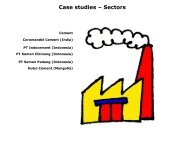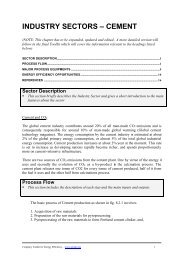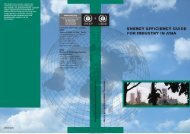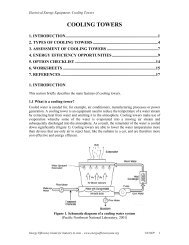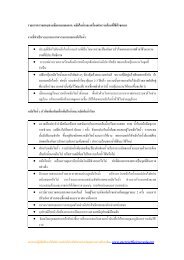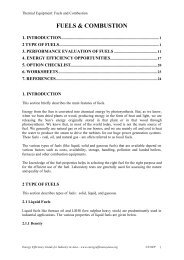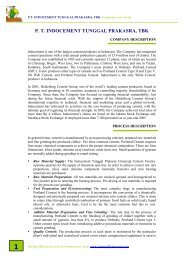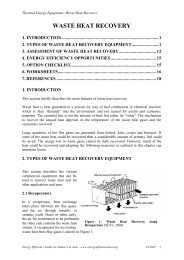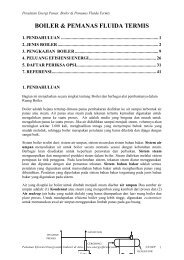Install steam turbine to existing boi… - Energy Efficiency Guide for ...
Install steam turbine to existing boi… - Energy Efficiency Guide for ...
Install steam turbine to existing boi… - Energy Efficiency Guide for ...
- No tags were found...
Create successful ePaper yourself
Turn your PDF publications into a flip-book with our unique Google optimized e-Paper software.
YUANPING CHEMICAL CO LTD: <strong>Install</strong> <strong>steam</strong> <strong>turbine</strong> <strong>to</strong> <strong>existing</strong> boilerYUANPING CHEMICAL COMPANY LIMITED<strong>Install</strong> <strong>steam</strong> <strong>turbine</strong> <strong>to</strong> <strong>existing</strong> boiler <strong>to</strong> generate electricity from superheated<strong>steam</strong>SUMMARY OF THE OPTIONYuanping city Chemical Co. Ltd is a middle-sized chemical plant with 1679 staff, located inShanxi Province in China and is Asia’s largest producers of oxalic acid, and also producedproducts like sodium <strong>for</strong>mat and <strong>for</strong>mic acid.During theplant assessment the Team found that the newly installed #9 boiler yields 35 <strong>to</strong>nsper hour (t/h) superheated <strong>steam</strong> (3.82MPa and 450°C ), But that the superheated <strong>steam</strong> wasused only <strong>for</strong> process heating. This boiler there<strong>for</strong>e had a large potential <strong>for</strong> cogeneration.Coincidentally, the company had also identified the cogeneration possibility and hadpurchased a second-hand 3MW <strong>turbine</strong>. The <strong>to</strong>tal investment was US$ 1.43 million, annualelectricity generation was 20196 MWh and the annual savings were US$ 0.61 million. It wascalculated that approximately 1700 <strong>to</strong>ns of coal can be saved each year because cogenerationis more efficient than separate electricity and heat production. As a result, CO 2 emissionreduction is 4260 <strong>to</strong>ns per year.KEY WORDSChina, Chemicals, Cogeneration, Boilers and Thermic Fluid Heaters, SteamOBSERVATIONSThe following was observed during the assessment of the plant:• In addition <strong>to</strong> the newly installed boiler #9, the company has five saturated <strong>steam</strong> boilers(1.27 MPa) and three superheated <strong>steam</strong> boilers (2.45 MPa, 400oC and 20t/h).• The <strong>steam</strong> production rate is 130 t/h and only 40 t/h of the <strong>to</strong>tal <strong>steam</strong> generation(2.45MPa, 400°C ) is used <strong>to</strong> generate electricity (3MWh = 30% of all electricity used onsite) through two non-condensing <strong>turbine</strong> genera<strong>to</strong>rs, and the exit <strong>steam</strong> from <strong>turbine</strong>s(0.3MPa, 260°C ) is used in process heating.• The newly installed boiler #9 uses duns and coal slacks <strong>to</strong> produce 35 <strong>to</strong>ns superheated<strong>steam</strong> (3.82 MPa and 450°C ). However, the superheated <strong>steam</strong> is only used <strong>for</strong> processheating, which means that there is potential <strong>for</strong> cogeneration.• Electricity use is high and electricity is one of the biggest costs <strong>to</strong> the companyOPTIONSThe team proposed <strong>to</strong> using the <strong>steam</strong> from boiler #9 <strong>for</strong> cogeneration. A detailed feasibilityanalysis was not necessary because the company also had identified this option prior <strong>to</strong> theassessment. The company installed an older, second-hand 3MWhr (due <strong>to</strong> financialconstraints) non-condensing <strong>turbine</strong> genera<strong>to</strong>r <strong>to</strong> generate electricity with the 3.82MPa,450°C superheated <strong>steam</strong>. The exit <strong>steam</strong> (0.7MPa, 250°C ) from the <strong>turbine</strong> was used <strong>for</strong>process heating. Cogeneration at boiler #9 started in February 2005.1<strong>Energy</strong> <strong>Efficiency</strong> <strong>Guide</strong> <strong>for</strong> Industry in Asia – www.energyefficiencyasia.org
RESULTSFinancial Benefits• Investment: US$ 1.43 million• Annual operation cost: US$ 11/MWh• Annual cost savings was US$ 0.61 million• Payback period: 2.3 yearsEnvironmental Benefits• Annual coal savings: 1700 <strong>to</strong>ns (this was calculated based on an 27 % efficiency gapbetween cogeneration and separate production of electricity and heat)• Annual GHG emission reduction: 4260 <strong>to</strong>ns CO 2Other results• Using the exit <strong>steam</strong> from <strong>turbine</strong> with a lower pressure and temperature instead ofsuperheated <strong>steam</strong>, process heating can improve the heat transfer rate and reduce theheating time.FOR MORE INFORMATIONGERIAP National Focal Point <strong>for</strong> ChinaMr. Wang Xin,Project Management Division I,Foreign Economic Cooperation Office of State Environmental Protection AdministrationNo. 115, Xizhimennei NanxiaojieBeijing 100035, the People's Republic of ChinaTel: +8610 66532316, E-mail: wang.xin@sepa.gov.cnGERIAP Company in ChinaMr. Song PeizhongShanxi Yuanping city Chemical Co. LtdNo 1, Santiao, Qianjin West Street, Yuanping city, Shanxi Province, P.R.ChinaTel: +860350, 8222889Disclaimer:This case study was prepared as part of the project “Greenhouse Gas Emission Reduction from Industry in Asiaand the Pacific” (GERIAP). While reasonable ef<strong>for</strong>ts have been made <strong>to</strong> ensure that the contents of thispublication are factually correct, UNEP does not accept responsibility <strong>for</strong> the accuracy or completeness of thecontents, and shall not be liable <strong>for</strong> any loss or damage that may be occasioned directly or indirectly throughthe use of, or reliance on, the contents of this publication. © UNEP, 2006.<strong>Energy</strong> <strong>Efficiency</strong> <strong>Guide</strong> <strong>for</strong> Industry in Asia– www.energyefficiencyasia.org 2



